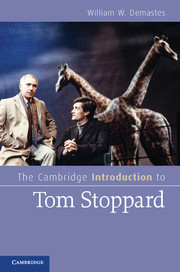Book contents
- Frontmatter
- Contents
- Illustrations
- Acknowledgements
- Introduction: Stoppardianism
- Professional chronology
- Chapter 1 Stoppard: briefly, a life in the theatre
- Chapter 2 Keys to Stoppard’s theatre
- Chapter 3 The breakthrough years
- Chapter 4 Playing with the stage
- Chapter 5 Science takes the stage
- Chapter 6 Love is in the air
- Chapter 7 Politics humanized
- Conclusion: The play’s the thing
- Appendix Stoppard’s theatre: a summary
- Notes
- Guide to further reading
- Index
Chapter 1 - Stoppard: briefly, a life in the theatre
Published online by Cambridge University Press: 05 December 2012
- Frontmatter
- Contents
- Illustrations
- Acknowledgements
- Introduction: Stoppardianism
- Professional chronology
- Chapter 1 Stoppard: briefly, a life in the theatre
- Chapter 2 Keys to Stoppard’s theatre
- Chapter 3 The breakthrough years
- Chapter 4 Playing with the stage
- Chapter 5 Science takes the stage
- Chapter 6 Love is in the air
- Chapter 7 Politics humanized
- Conclusion: The play’s the thing
- Appendix Stoppard’s theatre: a summary
- Notes
- Guide to further reading
- Index
Summary
Biography is the worst possible excuse for getting people wrong.
Indian Ink (5)Art cannot be subordinate to its subject, otherwise it is not art but biography, and biography is the mesh through which our real life escapes.
The Invention of Love (93)Many biographers, critics, and analysts have made much of Stoppard’s status as an outsider who, many claim, ultimately became more English than native-born citizens. His life as an outsider almost certainly has had an impact on his vision of the world as well as on his art, but how much of an impact is a matter of pure conjecture. Asked in 1998 about possible autobiographical elements in his work, Stoppard observed, “the area in which I feed off myself is really much more to do with thoughts I have had rather than days I have lived.” What is absolutely certain is that Stoppard has led a full and memorable life.
Tom Stoppard was born Tomas Straussler (nicknamed Tomik) on July 3, 1937 in Zlín, Czechoslovakia, the second son of Dr. Eugene Straussler and Martha Beckova Straussler. Tom’s father was a physician employed by Bata, a large shoe manufacturer world-renowned for its progressive, employee-friendly management style. In 1939, when World War II seemed imminent, Bata moved the Strausslers (and many other employees of Jewish descent) to its Singapore operation in order for them to escape Nazi persecution. The move, however, only changed the face of the enemy for the Strausslers. As Singapore fell to the Japanese in 1941, Tom’s family became refugees once again, and, first sailing toward Australia, their ship changed course and found its way to India. Tom’s father was delayed in his escape and went missing during the turmoil of Singapore’s fall. Years later he was reported to have died when the Japanese sank the ship he was on.
- Type
- Chapter
- Information
- The Cambridge Introduction to Tom Stoppard , pp. 14 - 24Publisher: Cambridge University PressPrint publication year: 2012



